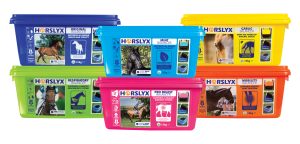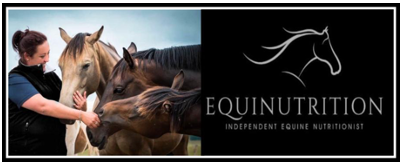“As we move into the New Year, many people begin to think ahead, even as far as Spring, planning fitness routines and reconsidering feed regimes. As these thoughts turn to the warmer months, people can become concerned about sugar levels. With this in mind, the team at Horslyx spoke again with Jennifer Little BSc (Hons) MSc RNutr at Equinutrition for her thoughts on what % of sugar is safe to feed our horses.”
This is a question I am frequently asked, but as with most questions relating to feed it’s not quite as simple as just checking a label for a certain percentage. As a nutritionist I need to use these percentages to calculate total intakes and ascertain safe and ideal usage for the individual horses ration. The percentage information in itself doesn’t provide me with this information, the required maths does. I often find it interesting that when I’m asked about ‘safe percentages’ it is more often than not in relation to sugars or starch rather than other nutrients such as fat or oil.
So why the concern in relation to sugar?
Simple Sugars and starches sit within the macro-nutrient group of Carbohydrates. The horse has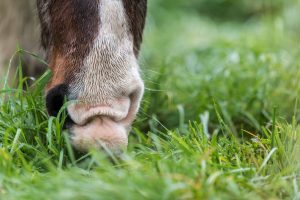 evolved to graze on a wide range of forage-based carbohydrates, these can be split into two groups hydrolyzable or fermentable. Hydrolyzable Carbohydrates (including sugar and starch) are ones that can be broken down by enzymes within the small intestines or foregut. Fermentable Carbohydrates however, need to be broken down by bacteria in the large intestines or hindgut. The digestion of both of these carbohydrate groups produces energy that the horse can then absorb and use.
evolved to graze on a wide range of forage-based carbohydrates, these can be split into two groups hydrolyzable or fermentable. Hydrolyzable Carbohydrates (including sugar and starch) are ones that can be broken down by enzymes within the small intestines or foregut. Fermentable Carbohydrates however, need to be broken down by bacteria in the large intestines or hindgut. The digestion of both of these carbohydrate groups produces energy that the horse can then absorb and use.
Research has shown that excessive sugar and starch in a horses diet can increase the risk of laminitis, Equine Gastric Ulcer Syndrome (EGUS), Polysaccharides Storage Myopathy (PSSM), and even increased flighty behaviours to name but a few. The wealth of research and its common interpretation from snippets has somewhat unfairly villainised sugar and starches in relation to the horses diet. Often the true concerns of feeding sugars and starches originates from where in the horses digestive system they are actually broken down and absorbed.
The horses digestive system structure can be split into two main regions. The foregut, consisting of the stomach and small intestines and then the hindgut, consisting of the caecum and small and large colon. The digestion in foregut is primarily driven by enzymes, breaking down fats, proteins, sugars, and starches. Whereas digestion in the hindgut is primarily driven by bacteria and protozoa, the populations of these care frequently referred to as the ‘gut biome’. These micro-organisms within the hindgut should breakdown fibre 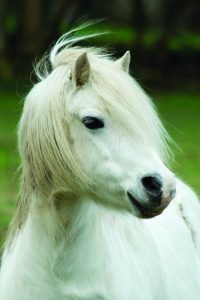 from the diet into Volatile Fatty Acids, which the horse can then absorb and use for energy. However, the gut biome can be sensitive to disruption if sugars and starches are still present as the food pass into the hindgut. Sugars ‘overflowing’ into the hindgut results in the rapid fermentation by some of the bacterial populations, which then produce lactic acid. This lactic acid then causes the death of other bacteria populations, releasing toxins within the gut and can result in a condition called hindgut acidosis. One of the more frequent causes of carbohydrates overflowing into the hindgut is when a horse has eaten a meal too high in sugar and starches. It would be easy to jump to a memory of that time the pony broke into the feed room, ate everyone’s buckets and needed to go straight onto laminitis or colic watch.
from the diet into Volatile Fatty Acids, which the horse can then absorb and use for energy. However, the gut biome can be sensitive to disruption if sugars and starches are still present as the food pass into the hindgut. Sugars ‘overflowing’ into the hindgut results in the rapid fermentation by some of the bacterial populations, which then produce lactic acid. This lactic acid then causes the death of other bacteria populations, releasing toxins within the gut and can result in a condition called hindgut acidosis. One of the more frequent causes of carbohydrates overflowing into the hindgut is when a horse has eaten a meal too high in sugar and starches. It would be easy to jump to a memory of that time the pony broke into the feed room, ate everyone’s buckets and needed to go straight onto laminitis or colic watch.
If a horses feed is provided in a manner that allows for the enzymes to breakdown and absorb the sugar and starches before they reach the hindgut, the risk of potential issues are significantly reduced or even negated. It is however possible to unknowingly provide sugar and starch in excess of this level within a single bucket feed. Especially if solely relying on a percentage stated on a label, as these can be misleading.
A good example to demonstrate why percentages listed on a label can be misleading is the Horslyx Balancer. It’s forgivable to understand why an owner may try to avoid feed stuffs that list ingredients typically high in sugar such as molasses. Or as with Horslyx balancer those feeds or supplements which contain sugar above the often quoted ‘safe’ 10% level.
Safe sugar and starch intake
In order to ensure safe feeding practises the listed percentages need to be converted to grams. This is because horses don’t actually eat percentages, they eat Kilograms, grams and even micrograms. The National Research Council (NRC) states that the safe levels of sugar and starch intake for horses and ponies is a maximum of 2g/kg of Body Weight /Meal, and for those considered sugar sensitive, such as those with Equine Metabolic Syndrome, the safe levels are at a maximum intake of 1g/kg Body Weight/Meal.
Converting Percentages to Grams
Initially the maths required to convert a percentage on a label into the actual grams eaten can seem a little daunting, but taken in steps it is relatively simple. Firstly, you need to know the percentage of sugar and starch as listed on the label, and secondly you need to know how many grams are being fed, then:
- Divide the listed % of sugar and starch by 100
- Multiply this number by the number of grams fed. This calculates the total grams of sugar and starch fed
- Divide this number by the horses weight (kg’s) to calculate the grams of sugar and starch per Kg body weight.
- If the amount fed is split over more than one feed then divide this number by the number of separate meals per day. This calculates the total grams of sugar and starch per kg body weight per meal.
Worked Example
For a 500kg horse Horslyx has a recommended daily intake of 250g per day, at 33% sugar, so this equals 82.5g of sugar per day. In the unusual situation where a horse would consume its total daily amount in one sitting this equates to 0.2g per Kg body weight per meal. This is well within the safe limit for even a sugar sensitive horse. In fact, a 500kg horse would need to eat 1.52kg Horslyx in one sitting to exceed this stated safe level. It is advisable to introduce a Horslyx balancer with a transition phase, just as I would recommend with the introduction any new feed. This transition phase will support a correct intake level, even with those ‘greedy’ individual horses. I would recommend initially introducing the Horslyx Balancer block for periods of 10 minutes and gradually increasing the time till free access is possible as the novelty wanes.
As well as ensuring the safe intake of sugars to support gut and overall health, 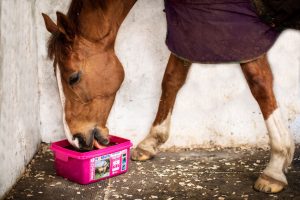 the Horslyx Balancer also ensures the sufficient supply of vitamins and minerals when provided alongside suitable forage sources. Once the introduction phase has been completed the Horslyx Balancer often achieves providing a balanced ration in a labour and cost-efficient method.
the Horslyx Balancer also ensures the sufficient supply of vitamins and minerals when provided alongside suitable forage sources. Once the introduction phase has been completed the Horslyx Balancer often achieves providing a balanced ration in a labour and cost-efficient method.
As with many of the factors I need to consider when I’m calculating a horses ration, it is often more complicated than just a percentage or list of ingredients. It involves taking the information on that product to calculate its suitability for that horse. By eliminating feeds or supplements based purely on a percentage or a listed ingredient I could be eliminating a perfectly suitable feed or supplement from the options available. In summary, horses don’t eat percentages, so percentages alone shouldn’t be a reason to choose or eliminate a feed or supplement in your horses diet.
